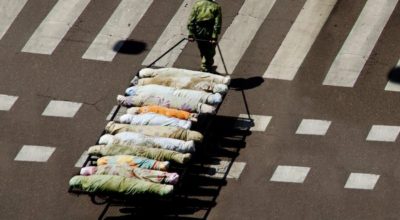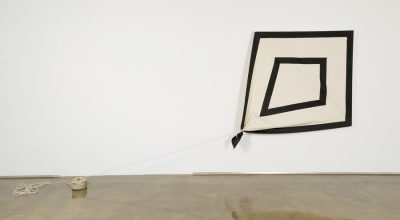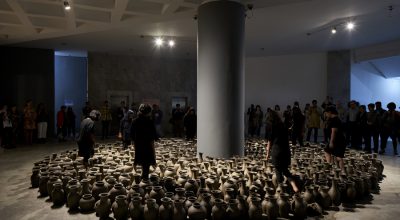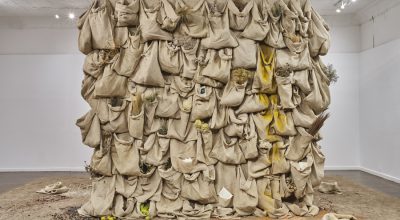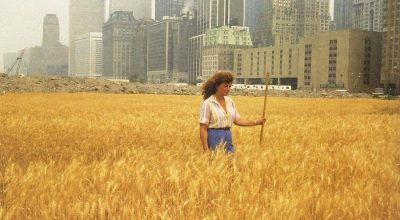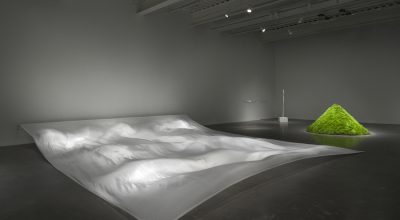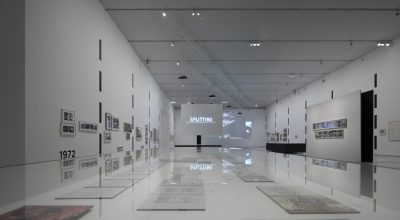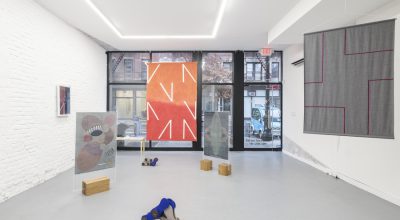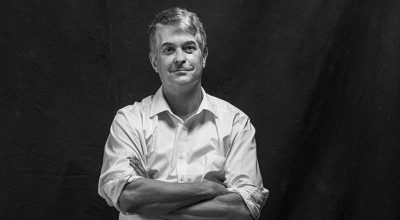English
AGAINST, AGAIN: ART UNDER ATTACK IN BRAZIL
The exhibition «Against, Again: Art Under Attack in Brazil» addresses the present transnational wave of authoritarianism by featuring a number of art practices that have responded to oppression in Brazil. Since the rise of a conservative political movement in the last few years that resulted in the election of a far-right president in 2018, threats and attacks against politicians, activists, intellectuals and artists have skyrocketed.
Eugenio Espinoza:good Blue Day
The Piero Atchugarry Gallery presented «Good Blue Day», a solo exhibition of new work by Venezuelan conceptual artist Eugenio Espinoza, including sculpture, painting, installation and performance. Espinoza began his career by subverting our understanding of the Modernist grid, and is celebrated for his radical works that reacted to the dominant movements of geometric abstraction and Kinetic art in Venezuela in the 1960’s and 1970’s.
Paz Errázuriz: Próceres [National Heroes]
‘Próceres [National Heroes]’ is a newly printed series (2018) that Paz Errázuriz originally took in 1983. Taken in a government run warehouse in Chile, ‘Próceres [National Heroes]’ captures the last evidence of toppled Chilean statues. These monuments had been violently dismantled and damaged during the height of Augusto Pinochet’s dictatorship (1974–1990). This exhibition at Cecilia Brunson Projects in London is the first public showing of this series.
Seismic Movements.dhaka Art Summit 2020
Convening a critical mass of artists, thinkers and participants, the Dhaka Art Summit 2020 reconsiders (art) histories, movement, borders and fault lines. Its fifth edition, Seismic Movements, takes place February 7-15 at the Shilpakala Academy in Dhaka, Bangladesh, expanding its geographic and temporal scope and looking at movements generated from energy released from pressure -geologically, socially, politically, climatically. Thus, the Summit is not just an exhibition, it is a movement. And is neither a biennale. Although it takes place every two years, this format is simply for organisational and logistical purposes.
Solange Pessoa:longilonge
Ballroom Marfa presents the first solo museum exhibition in the United States of Brazilian artist Solange Pessoa (Ferros, 1961). Pessoa’s practice is deeply rooted in land, human and natural history. In this focused exhibition, she gathers together references, materials and iconography from the environment of her homeland in Minas Gerais and Far West Texas, creating a conversation between shared forms and interwoven cosmogonies.
Agnes Denes:a Pioneer of Conceptual And Environmental Art
The Shed presents the most comprehensive retrospective exhibition to date of the work of Agnes Denes (b. 1931), a leading figure in Conceptual and Environmental art. «Agnes Denes: Absolutes and Intermediates» brings together more than 150 works in a broad range of media spanning Denes’s 50-year career, including three new works commissioned by The Shed. “Agnes Denes not only anticipated the man-made destruction of natural habitats at a moment when few people were paying attention, but much of her work features solutions to ecological crises that we are now facing,” said Hans Ulrich Obrist, The Shed’s senior program advisor.
New Museum Presents a Major Retrospective of Hans Haacke
For six decades, Haacke has been a pioneer in kinetic art, environmental art, Conceptual art, and institutional critique. This retrospective at the New Museum brings together a wide range of works, focusing in particular on how Haacke expanded the parameters of his practice to encompass the social, political, and economic structures in which art is produced, circulated, and displayed. The exhibition includes a number of Haacke’s rarely seen kinetic works, environmental sculptures, and visitor polls, all of which were central to discussions around systems aesthetics in art during that period. It also features works that address the corporate sponsorship of major art institutions and political interference, and more recent works that consider the intersection of global capitalism, nationalism, and humanitarian crises around the world.
Passing Through Architecture:the 10 Years of Gordon Matta-clark
As the first large-scale exhibition of Matta-Clark’s work in China, «Passing Through Architecture: The 10 Years of Gordon Matta-Clark» traces the remarkable thinking and avant-garde works of this interdisciplinary artist from 1968 to 1978 with more than 400 drawings, photo-works, films and archival documents. It aims to examine Matta-Clark’s relentless exploration of topics like architecture, space, biology and ecology; to question the nature of architecture, the natural environment, and human life beyond the scope of architecture 50 years after the artist’s return to New York, and to rethink the multi-faceted legacy left by modernist urban planning ideas.
Johanna Unzueta & Felipe Mujica:where Land And Sea Melt Into Sky
New York-based gallery Proxyco presents «Where Land and Sea Melt into Sky», an exhibition of works by artists Johanna Unzueta (Chile, 1974) and Felipe Mujica (Chile, 1974). The exhibition foregrounds the notion of the artwork as a product of labor, pointing at process, craft work, and collaboration as significant elements of their artistic creation. Working together but maintaining separate practices, the artists have influenced each other for more than 20 years through the exchange of ideas, techniques, and methods.
Dan Cameron on Curatorial Practice And The Work of Gianfranco Foschino
Although this is not an exhibition focused on water scarcity, nor on the consequences of climate change, it does establish a clear link between the sublime image of the landscape and the terrible state of our current situation. In a room next to SED operates the Centro de Estudios del Agua [Water Studies Center] (CEA), which continually evokes the idea of the individual’s potential agency in the face of climate crisis.

